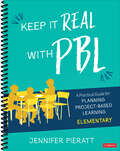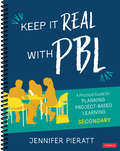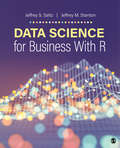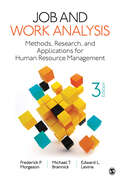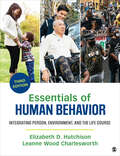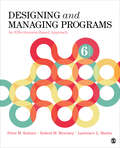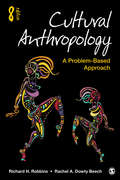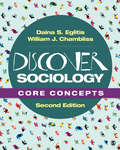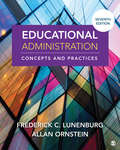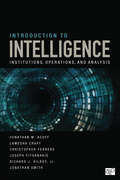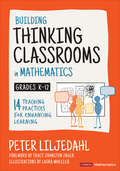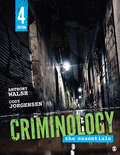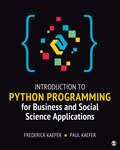- Table View
- List View
Keep It Real With PBL, Elementary: A Practical Guide for Planning Project-Based Learning (Corwin Teaching Essentials)
by Jennifer R. PierattPlan enriching Project-Based Learning experiences with ease! The book′s companion website features an updated guide to help teachers integrate technology into PBL experiences for online and blended learning instruction. Is project-planning a project in and of itself? Does project-based learning (PBL) feel more like a pipe dream than a reality in your classroom? Dr. Jennifer Pieratt, a consultant and former teacher herself, knows just where you′re coming from. Developed from the author′s experience in the trenches of project-based learning over the past decade, this book will lead you through the planning process for an authentic PBL experience in a clear and efficient way. Project-based learning has been found to develop workforce readiness, innovation, and student achievement. In this book, the keys to implementing PBL effectively are explored in a simple, easy-to-use format. In addition to thought-provoking questions for journaling, readers will find a visually accessible style featuring • #realtalk soundbites that honor the challenges to implementing PBL • Tips and resources to support the project-planning process • Planning forms to guide you through planning your projects • Key terminology and acronyms in PBL • Exercises to help you reflect and process throughout your project plans If mastering a PBL framework is on your list, prepare to cross it off with the help of this book! Foreword INDIES Book of the Year Awards Winner
Keep It Real With PBL, Secondary: A Practical Guide for Planning Project-Based Learning (Corwin Teaching Essentials)
by Jennifer R. PierattLet′s Get Real About PBL The book′s companion website features an updated guide to help teachers integrate technology into PBL experiences for online and blended learning instruction. Does project-based learning (PBL) feel just out of reach in in your secondary classroom? Is project-planning an overwhelming project in and of itself? Dr. Jennifer Pieratt, a consultant and former teacher, knows firsthand how challenging designing projects can be, especially for secondary teachers with large caseloads and short class periods to engage in meaningful teaching and learning. In this hands-on, interactive guide, Pieratt supports secondary teachers through the iterative process of planning authentic project-based learning experiences. Using backward design, she gives teachers ready to use strategies for identifying the best concepts to tackle in PBL experiences, brainstorming realistic projects, facilitating meaningful learning, and creating formative and summative assessments. The book is visually accessible in style and features #realtalk soundbites that tackle the challenges to implementing PBL Tips and resources to support the project-planning process Planning forms to guide you through planning your projects Key terminology and acronyms in PBL Exercises to help you reflect and process throughout your project plans Master PBL planning with this clear, efficient, and easy-to-use guide to creating enriching experiences for your students!
Keep It Real With PBL, Secondary: A Practical Guide for Planning Project-Based Learning (Corwin Teaching Essentials)
by Jennifer R. PierattLet′s Get Real About PBL The book′s companion website features an updated guide to help teachers integrate technology into PBL experiences for online and blended learning instruction. Does project-based learning (PBL) feel just out of reach in in your secondary classroom? Is project-planning an overwhelming project in and of itself? Dr. Jennifer Pieratt, a consultant and former teacher, knows firsthand how challenging designing projects can be, especially for secondary teachers with large caseloads and short class periods to engage in meaningful teaching and learning. In this hands-on, interactive guide, Pieratt supports secondary teachers through the iterative process of planning authentic project-based learning experiences. Using backward design, she gives teachers ready to use strategies for identifying the best concepts to tackle in PBL experiences, brainstorming realistic projects, facilitating meaningful learning, and creating formative and summative assessments. The book is visually accessible in style and features #realtalk soundbites that tackle the challenges to implementing PBL Tips and resources to support the project-planning process Planning forms to guide you through planning your projects Key terminology and acronyms in PBL Exercises to help you reflect and process throughout your project plans Master PBL planning with this clear, efficient, and easy-to-use guide to creating enriching experiences for your students!
Data Science for Business With R
by Jeffrey S. Saltz Jeffrey Morgan StantonData Science for Business with R, written by Jeffrey S. Saltz and Jeffrey M. Stanton, focuses on the concepts foundational for students starting a business analytics or data science degree program. To keep the book practical and applied, the authors feature a running case using a global airline business’s customer survey dataset to illustrate how to turn data in business decisions, in addition to numerous examples throughout. To aid in usability beyond the classroom, the text features full integration of freely-available R and RStudio software, one of the most popular data science tools available. Designed for students with little to no experience in related areas like computer science, the book chapters follow a logical order from introduction and installation of R and RStudio, working with data architecture, undertaking data collection, performing data analysis, and transitioning to data archiving and presentation. Each chapter follows a familiar structure, starting with learning objectives and background, following the basic steps of functions alongside simple examples, applying these functions to the case study, and ending with chapter challenge questions, sources, and a list of R functions so students know what to expect in each step of their data science course. Data Science for Business with R provides readers with a straightforward and applied guide to this new and evolving field.
Data Science for Business With R
by Jeffrey S. Saltz Jeffrey Morgan StantonData Science for Business with R, written by Jeffrey S. Saltz and Jeffrey M. Stanton, focuses on the concepts foundational for students starting a business analytics or data science degree program. To keep the book practical and applied, the authors feature a running case using a global airline business’s customer survey dataset to illustrate how to turn data in business decisions, in addition to numerous examples throughout. To aid in usability beyond the classroom, the text features full integration of freely-available R and RStudio software, one of the most popular data science tools available. Designed for students with little to no experience in related areas like computer science, the book chapters follow a logical order from introduction and installation of R and RStudio, working with data architecture, undertaking data collection, performing data analysis, and transitioning to data archiving and presentation. Each chapter follows a familiar structure, starting with learning objectives and background, following the basic steps of functions alongside simple examples, applying these functions to the case study, and ending with chapter challenge questions, sources, and a list of R functions so students know what to expect in each step of their data science course. Data Science for Business with R provides readers with a straightforward and applied guide to this new and evolving field.
Job and Work Analysis: Methods, Research, and Applications for Human Resource Management
by Edward L. Levine Frederick P. Morgeson Michael T. BrannickJob and Work Analysis: Methods, Research, and Applications for Human Resource Management provides students and professionals alike with an in-depth exploration of job analysis. Job analysis encompasses a wide range of crucial topics that help us understand what people do at work and why. This one-of-a-kind text expertly unpacks the best job analysis methods and then illustrates how to apply these methods to solve some of the most common workplace problems. Readers will learn the best practices for helping people work smarter, improving hiring and training, making jobs safer, and providing a satisfying work environment. The new Third Edition includes new references, the latest research findings, and expanded discussions of competency models, teams, and O*NET.
Essentials of Human Behavior: Integrating Person, Environment, and the Life Course
by Elizabeth D. Hutchison Leanne Wood CharlesworthEssentials of Human Behavior combines Elizabeth D. Hutchison’s two best-selling Dimensions of Human Behavior volumes into a single streamlined volume for understanding human behavior. The text presents a multidimensional framework integrating person, environment, and time to show students the dynamic, changing nature of person-in-environment. In this Third Edition, Hutchison is joined by new co-author Leanne Wood Charlesworth, who uses her practice and teaching experience to help organize the book’s cutting-edge research and bring it into the classroom. The text will thoroughly support students′ understanding of human behavior theories and research and their applications to social work engagement, assessment, intervention, and evaluation across all levels of practice. This title is accompanied by a complete teaching and learning package.
Essentials of Human Behavior: Integrating Person, Environment, and the Life Course
by Elizabeth D. Hutchison Leanne Wood CharlesworthEssentials of Human Behavior combines Elizabeth D. Hutchison’s two best-selling Dimensions of Human Behavior volumes into a single streamlined volume for understanding human behavior. The text presents a multidimensional framework integrating person, environment, and time to show students the dynamic, changing nature of person-in-environment. In this Third Edition, Hutchison is joined by new co-author Leanne Wood Charlesworth, who uses her practice and teaching experience to help organize the book’s cutting-edge research and bring it into the classroom. The text will thoroughly support students′ understanding of human behavior theories and research and their applications to social work engagement, assessment, intervention, and evaluation across all levels of practice. This title is accompanied by a complete teaching and learning package.
Designing and Managing Programs: An Effectiveness-Based Approach
by Peter M. Kettner Lawrence L. Martin Robert M. MoroneyThis classic text for social work and human services helps readers grasp the meaning and significance of measuring performance and evaluating outcomes. Hands-on and practical, Designing and Managing Programs incorporates the principles of effectiveness-based planning as it addresses the steps of designing, implementing, and evaluating a human services program at the local agency level. Written by leaders in the field, it guides students through the process from beginning to end. Meaningful examples—from problem analysis and needs assessment to evaluating effectiveness and calculating costs—enhance reader understanding of how concepts are implemented in the real world. The Sixth Edition contains new examples and references, and updates based on changes to federal regulations. An instructor website includes essay questions, PowerPoint slides, and suggested assignments designed by the authors.
Designing and Managing Programs: An Effectiveness-Based Approach
by Peter M. Kettner Lawrence L. Martin Robert M. MoroneyThis classic text for social work and human services helps readers grasp the meaning and significance of measuring performance and evaluating outcomes. Hands-on and practical, Designing and Managing Programs incorporates the principles of effectiveness-based planning as it addresses the steps of designing, implementing, and evaluating a human services program at the local agency level. Written by leaders in the field, it guides students through the process from beginning to end. Meaningful examples—from problem analysis and needs assessment to evaluating effectiveness and calculating costs—enhance reader understanding of how concepts are implemented in the real world. The Sixth Edition contains new examples and references, and updates based on changes to federal regulations. An instructor website includes essay questions, PowerPoint slides, and suggested assignments designed by the authors.
Cultural Anthropology: A Problem-Based Approach
by Richard H. Robbins Rachel A. Dowty BeechNow with SAGE Publishing! In a first-of-its-kind format, Cultural Anthropology: A Problem-Based Approach is organized by problems and questions rather than topics, creating a natural discussion of traditional anthropological concerns such as kinship, caste, gender roles, and religion. This brief text promotes critical thinking through meaningful exercises, case studies, and simulations. Students will learn how to analyze their own culture and gain the tools to understand the cultures of other societies. The Eighth Edition has been thoroughly updated and reorganized to emphasize contemporary issues around social and economic inequality, gender identity, and more. Included with this title: The password-protected Instructor Resource Site (formally known as SAGE Edge) offers access to all text-specific resources, including a test bank and editable, chapter-specific PowerPoint® slides.
Cultural Anthropology: A Problem-Based Approach
by Richard H. Robbins Rachel A. Dowty BeechNow with SAGE Publishing! In a first-of-its-kind format, Cultural Anthropology: A Problem-Based Approach is organized by problems and questions rather than topics, creating a natural discussion of traditional anthropological concerns such as kinship, caste, gender roles, and religion. This brief text promotes critical thinking through meaningful exercises, case studies, and simulations. Students will learn how to analyze their own culture and gain the tools to understand the cultures of other societies. The Eighth Edition has been thoroughly updated and reorganized to emphasize contemporary issues around social and economic inequality, gender identity, and more. Included with this title: The password-protected Instructor Resource Site (formally known as SAGE Edge) offers access to all text-specific resources, including a test bank and editable, chapter-specific PowerPoint® slides.
Discover Sociology: Core Concepts
by William J. Chambliss Daina S. Eglitis2020 SAGE Keith Roberts Teaching Innovations Award—enabling graduate students and early career faculty to attend the annual ASA pre-conference teaching and learning workshop. Discover Sociology: Core Concepts explores sociology as a discipline of curious minds, with the theoretical, conceptual, and empirical tools needed to understand, analyze, and even change the world. It is adapted from Discover Sociology, Fourth Edition and offers in-depth coverage of 12 high-priority topics that are at the core of almost all introductory sociology courses. The Second Edition of Core Concepts maintains its reader-friendly narrative and the hallmark themes of the parent book, including the unequal distribution of power in society ("Inequality Matters"), the sociological imagination ("Private Lives, Public Issues"), career skills ("What Can I Do With a Sociology Degree?") and civil discourse ("Discover and Debate"). In response to reader’s requests, this edition features expanded coverage of issues such as intersectionality, popular culture, and changes in the contemporary population of college students in the U.S. Additionally, updated social indicators bring in the latest data available from the U.S. Census Bureau, the Bureau of Labor Statistics, the Centers for Disease Control and Prevention, and the Pew Research Center, among others, to ensure that discussions and figures remain timely. This title is accompanied by a complete teaching and learning package. Digital Option / Courseware SAGE Vantage is an intuitive digital platform that delivers this text’s content and course materials in a learning experience that offers auto-graded assignments and interactive multimedia tools, all carefully designed to ignite student engagement and drive critical thinking. Built with you and your students in mind, it offers simple course set-up and enables students to better prepare for class. Assignable Video with Assessment Assignable video (available with SAGE Vantage) is tied to learning objectives and curated exclusively for this text to bring concepts to life. LMS Cartridge (formerly known as SAGE Coursepacks): Import this title’s instructor resources into your school’s learning management system (LMS) and save time. Don’t use an LMS? You can still access all of the same online resources for this title via the password-protected Instructor Resource Site. SAGE Lecture Spark: Designed to save you time and ignite student engagement, these free weekly lecture launchers focus on current event topics tied to key concepts in Sociology.
Discover Sociology: Core Concepts
by William J. Chambliss Daina S. Eglitis2020 SAGE Keith Roberts Teaching Innovations Award—enabling graduate students and early career faculty to attend the annual ASA pre-conference teaching and learning workshop. Discover Sociology: Core Concepts explores sociology as a discipline of curious minds, with the theoretical, conceptual, and empirical tools needed to understand, analyze, and even change the world. It is adapted from Discover Sociology, Fourth Edition and offers in-depth coverage of 12 high-priority topics that are at the core of almost all introductory sociology courses. The Second Edition of Core Concepts maintains its reader-friendly narrative and the hallmark themes of the parent book, including the unequal distribution of power in society ("Inequality Matters"), the sociological imagination ("Private Lives, Public Issues"), career skills ("What Can I Do With a Sociology Degree?") and civil discourse ("Discover and Debate"). In response to reader’s requests, this edition features expanded coverage of issues such as intersectionality, popular culture, and changes in the contemporary population of college students in the U.S. Additionally, updated social indicators bring in the latest data available from the U.S. Census Bureau, the Bureau of Labor Statistics, the Centers for Disease Control and Prevention, and the Pew Research Center, among others, to ensure that discussions and figures remain timely. This title is accompanied by a complete teaching and learning package. Digital Option / Courseware SAGE Vantage is an intuitive digital platform that delivers this text’s content and course materials in a learning experience that offers auto-graded assignments and interactive multimedia tools, all carefully designed to ignite student engagement and drive critical thinking. Built with you and your students in mind, it offers simple course set-up and enables students to better prepare for class. Assignable Video with Assessment Assignable video (available with SAGE Vantage) is tied to learning objectives and curated exclusively for this text to bring concepts to life. LMS Cartridge (formerly known as SAGE Coursepacks): Import this title’s instructor resources into your school’s learning management system (LMS) and save time. Don’t use an LMS? You can still access all of the same online resources for this title via the password-protected Instructor Resource Site. SAGE Lecture Spark: Designed to save you time and ignite student engagement, these free weekly lecture launchers focus on current event topics tied to key concepts in Sociology.
Educational Administration: Concepts and Practices
by Fred C. Lunenburg Allan OrnsteinNow with SAGE Publishing! The bestselling Educational Administration: Concepts and Practices has been considered the standard for all educational administration textbooks for three decades. A thorough and comprehensive revision, the Seventh Edition continues to balance theory and research with practical application for prospective and practicing school administrators. While maintaining the book’s hallmark features—a friendly and approachable writing style, cutting-edge content, and compelling pedagogy—authors Frederick C. Lunenburg and Allan Ornstein present research-based practices while discussing topical issues facing school administrators today. Included with this title: The password-protected Instructor Resource Site (formally known as SAGE Edge) offers access to all text-specific resources, including a test bank and editable, chapter-specific PowerPoint® slides.
Educational Administration: Concepts and Practices
by Fred C. Lunenburg Allan OrnsteinNow with SAGE Publishing! The bestselling Educational Administration: Concepts and Practices has been considered the standard for all educational administration textbooks for three decades. A thorough and comprehensive revision, the Seventh Edition continues to balance theory and research with practical application for prospective and practicing school administrators. While maintaining the book’s hallmark features—a friendly and approachable writing style, cutting-edge content, and compelling pedagogy—authors Frederick C. Lunenburg and Allan Ornstein present research-based practices while discussing topical issues facing school administrators today. Included with this title: The password-protected Instructor Resource Site (formally known as SAGE Edge) offers access to all text-specific resources, including a test bank and editable, chapter-specific PowerPoint® slides.
Perspectives on International Relations: Power, Institutions, and Ideas
by Henry R. Nau"Nau clarifies that which is complicated, thereby allowing students to make better sense of their world and to become better global citizens." —Stewart Dippel, University of the Ozarks Henry R. Nau’s best-selling book, Perspectives on International Relations, is admired for its even-handed presentation of realism, liberalism, constructivism, and critical theory and for integrating these perspectives in every chapter. Students are able to explore the ways these different perspectives shape our understanding of the root causes of historical events and current controversies, and then think critically about the world’s most urgent issues. The new Seventh Edition includes updates on Brexit, the rise of nationalism, the escalation of terrorism, the use of social media in political protests around the world, and continuing developments in North Korea, Syria, Iran, China, and Russia. A Complete Teaching & Learning Package LMS Cartridge (formally known as SAGE Coursepacks) Import this title’s instructor resources into your school’s learning management system (LMS) and save time. Don’t use an LMS? You can still access all of the same online resources for this title via the password-protected Instructor Resource Site. SAGE course outcomes: Measure Results, Track Success Outlined in your text and mapped to chapter learning objectives, SAGE course outcomes are crafted with specific course outcomes in mind and vetted by advisors in the field. See how SAGE course outcomes tie in with this book’s chapter-level objectives.
Perspectives on International Relations: Power, Institutions, and Ideas
by Henry R. Nau"Nau clarifies that which is complicated, thereby allowing students to make better sense of their world and to become better global citizens." —Stewart Dippel, University of the Ozarks Henry R. Nau’s best-selling book, Perspectives on International Relations, is admired for its even-handed presentation of realism, liberalism, constructivism, and critical theory and for integrating these perspectives in every chapter. Students are able to explore the ways these different perspectives shape our understanding of the root causes of historical events and current controversies, and then think critically about the world’s most urgent issues. The new Seventh Edition includes updates on Brexit, the rise of nationalism, the escalation of terrorism, the use of social media in political protests around the world, and continuing developments in North Korea, Syria, Iran, China, and Russia. A Complete Teaching & Learning Package LMS Cartridge (formally known as SAGE Coursepacks) Import this title’s instructor resources into your school’s learning management system (LMS) and save time. Don’t use an LMS? You can still access all of the same online resources for this title via the password-protected Instructor Resource Site. SAGE course outcomes: Measure Results, Track Success Outlined in your text and mapped to chapter learning objectives, SAGE course outcomes are crafted with specific course outcomes in mind and vetted by advisors in the field. See how SAGE course outcomes tie in with this book’s chapter-level objectives.
Introduction to Intelligence: Institutions, Operations, and Analysis
by Jonathan Smith Jonathan M. Acuff Richard J. Kilroy Joseph Fitsanakis Lamesha Craft Christopher J. FerreroIntroduction to Intelligence: Institutions, Operations, and Analysis offers a strategic, international, and comparative approach to covering intelligence organizations and domestic security issues. Written by multiple authors, each chapter draws on the author′s professional and scholarly expertise in the subject matter. As a core text for an introductory survey course in intelligence, this text provides readers with a comprehensive introduction to intelligence, including institutions and processes, collection, communications, and common analytic methods.
Introduction to Intelligence: Institutions, Operations, and Analysis
by Jonathan Smith Jonathan M. Acuff Richard J. Kilroy Joseph Fitsanakis Lamesha Craft Christopher J. FerreroIntroduction to Intelligence: Institutions, Operations, and Analysis offers a strategic, international, and comparative approach to covering intelligence organizations and domestic security issues. Written by multiple authors, each chapter draws on the author′s professional and scholarly expertise in the subject matter. As a core text for an introductory survey course in intelligence, this text provides readers with a comprehensive introduction to intelligence, including institutions and processes, collection, communications, and common analytic methods.
Building Thinking Classrooms in Mathematics, Grades K-12: 14 Teaching Practices for Enhancing Learning (Corwin Mathematics Series)
by Peter LiljedahlA thinking student is an engaged student Teachers often find it difficult to implement lessons that help students go beyond rote memorization and repetitive calculations. In fact, institutional norms and habits that permeate all classrooms can actually be enabling "non-thinking" student behavior. Sparked by observing teachers struggle to implement rich mathematics tasks to engage students in deep thinking, Peter Liljedahl has translated his 15 years of research into this practical guide on how to move toward a thinking classroom. Building Thinking Classrooms in Mathematics, Grades K–12 helps teachers implement 14 optimal practices for thinking that create an ideal setting for deep mathematics learning to occur. This guide Provides the what, why, and how of each practice and answers teachers’ most frequently asked questions Includes firsthand accounts of how these practices foster thinking through teacher and student interviews and student work samples Offers a plethora of macro moves, micro moves, and rich tasks to get started Organizes the 14 practices into four toolkits that can be implemented in order and built on throughout the year When combined, these unique research-based practices create the optimal conditions for learner-centered, student-owned deep mathematical thinking and learning, and have the power to transform mathematics classrooms like never before.
Building Thinking Classrooms in Mathematics, Grades K-12: 14 Teaching Practices for Enhancing Learning (Corwin Mathematics Series)
by Peter LiljedahlA thinking student is an engaged student Teachers often find it difficult to implement lessons that help students go beyond rote memorization and repetitive calculations. In fact, institutional norms and habits that permeate all classrooms can actually be enabling "non-thinking" student behavior. Sparked by observing teachers struggle to implement rich mathematics tasks to engage students in deep thinking, Peter Liljedahl has translated his 15 years of research into this practical guide on how to move toward a thinking classroom. Building Thinking Classrooms in Mathematics, Grades K–12 helps teachers implement 14 optimal practices for thinking that create an ideal setting for deep mathematics learning to occur. This guide Provides the what, why, and how of each practice and answers teachers’ most frequently asked questions Includes firsthand accounts of how these practices foster thinking through teacher and student interviews and student work samples Offers a plethora of macro moves, micro moves, and rich tasks to get started Organizes the 14 practices into four toolkits that can be implemented in order and built on throughout the year When combined, these unique research-based practices create the optimal conditions for learner-centered, student-owned deep mathematical thinking and learning, and have the power to transform mathematics classrooms like never before.
Criminology: The Essentials
by Anthony Walsh Cody JorgensenAnthony Walsh and Cody Jorgensen’s Criminology: The Essentials introduces students to major theoretical perspectives and topics in a concise, easy-to-read format. This straightforward overview of key subject areas in criminology thoroughly covers the most up-to-date advances in theory and research while challenging students to consider the applications of these theories and their policy implications. The Fourth Edition includes new topics, events, and developments in criminology.
Criminology: The Essentials
by Anthony Walsh Cody JorgensenAnthony Walsh and Cody Jorgensen’s Criminology: The Essentials introduces students to major theoretical perspectives and topics in a concise, easy-to-read format. This straightforward overview of key subject areas in criminology thoroughly covers the most up-to-date advances in theory and research while challenging students to consider the applications of these theories and their policy implications. The Fourth Edition includes new topics, events, and developments in criminology.
Introduction to Python Programming for Business and Social Science Applications
by Paul Kaefer Frederick KaeferWould you like to gather big datasets, analyze them, and visualize the results, all in one program? If this describes you, then Introduction to Python Programming for Business and Social Science Applications is the book for you. Authors Frederick Kaefer and Paul Kaefer walk you through each step of the Python package installation and analysis process, with frequent exercises throughout so you can immediately try out the functions you’ve learned. Written in straightforward language for those with no programming background, this book will teach you how to use Python for your research and data analysis. Instead of teaching you the principles and practices of programming as a whole, this application-oriented text focuses on only what you need to know to research and answer social science questions. The text features two types of examples, one set from the General Social Survey and one set from a large taxi trip dataset from a major metropolitan area, to help readers understand the possibilities of working with Python. Chapters on installing and working within a programming environment, basic skills, and necessary commands will get you up and running quickly, while chapters on programming logic, data input and output, and data frames help you establish the basic framework for conducting analyses. Further chapters on web scraping, statistical analysis, machine learning, and data visualization help you apply your skills to your research. More advanced information on developing graphical user interfaces (GUIs) help you create functional data products using Python to inform general users of data who don’t work within Python. First there was IBM® SPSS®, then there was R, and now there′s Python. Statistical software is getting more aggressive - let authors Frederick Kaefer and Paul Kaefer help you tame it with Introduction to Python Programming for Business and Social Science Applications.
